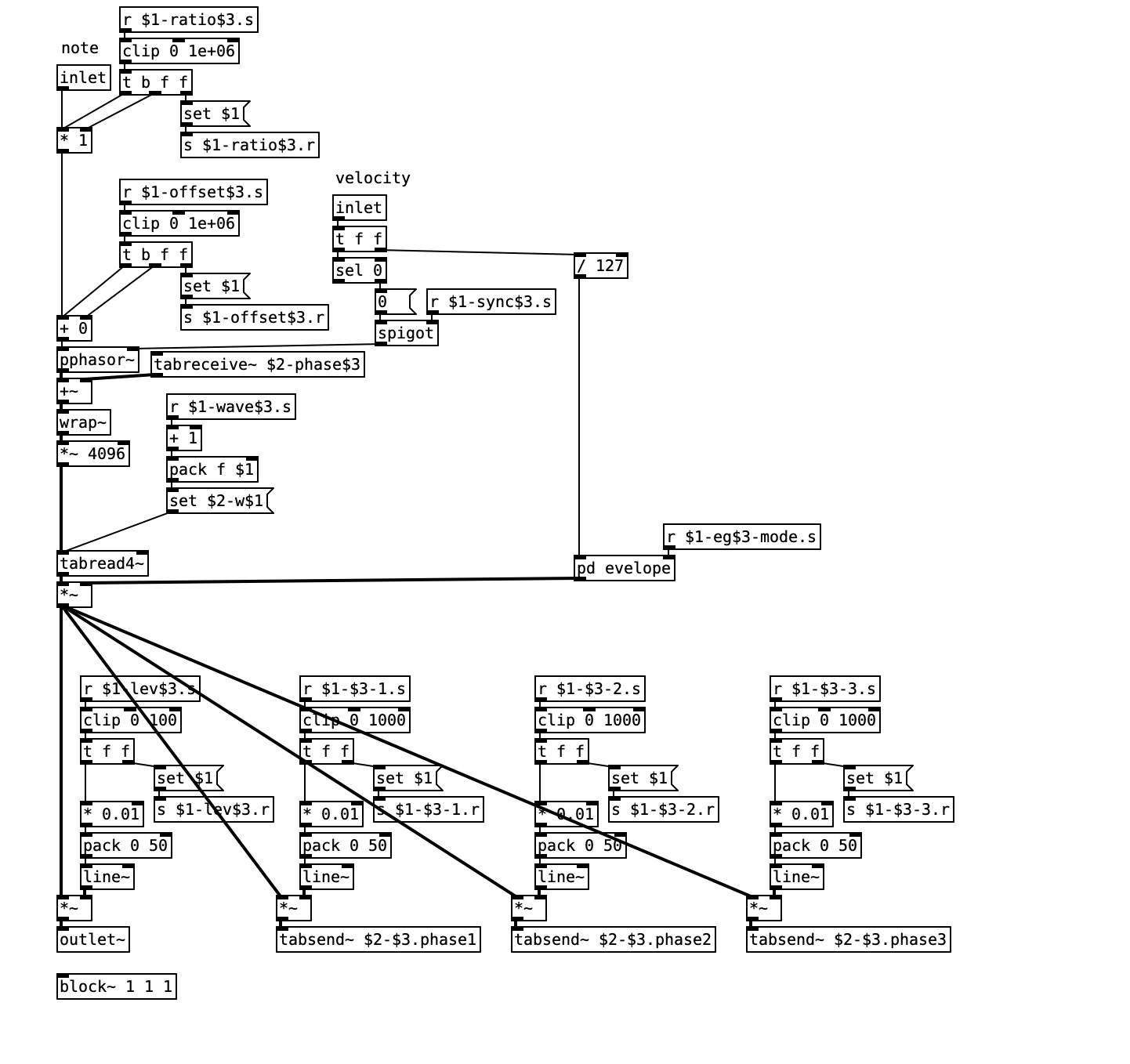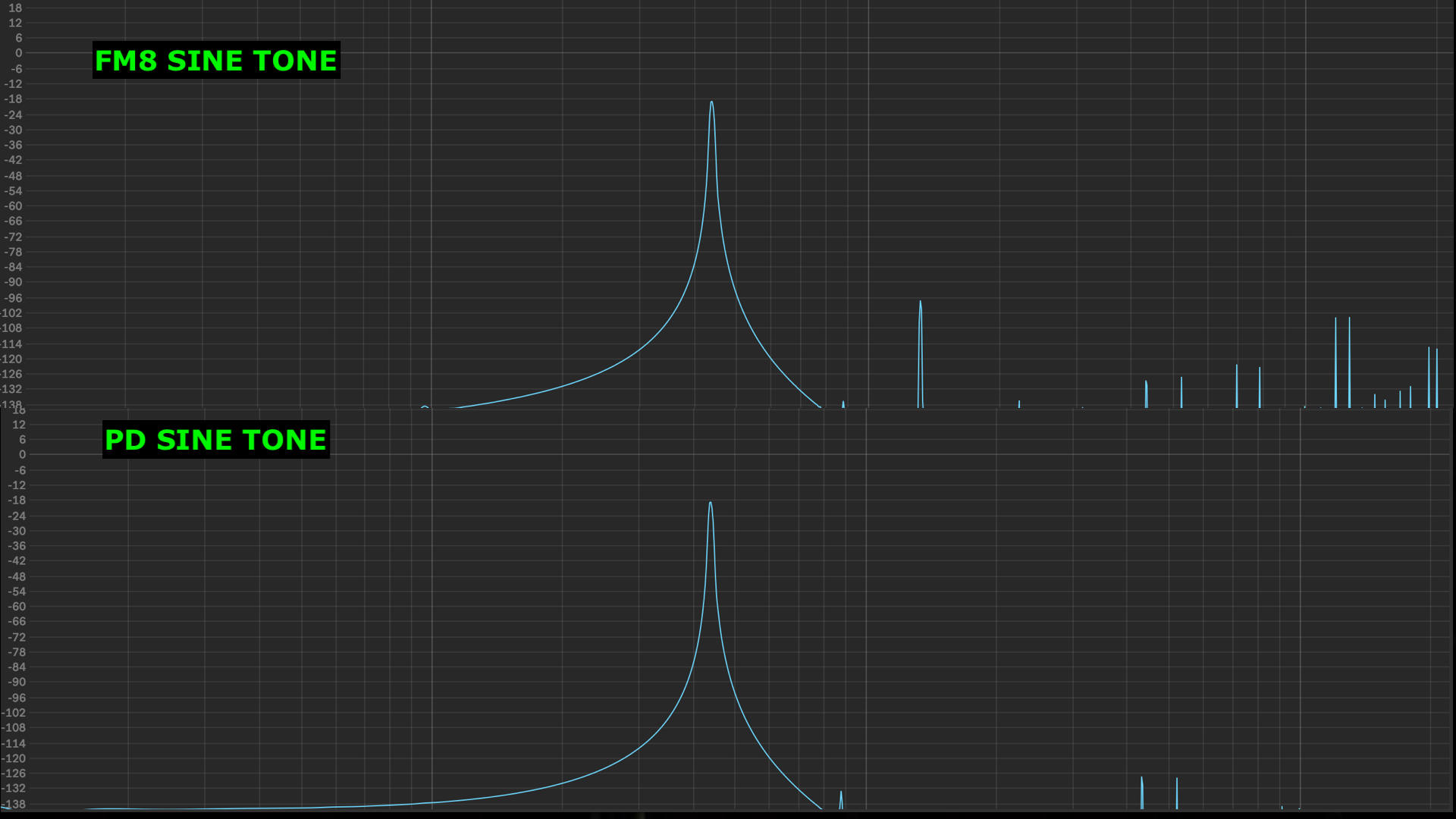-
RandLaneFly
posted in abstract~ • read more@weightless Hey great patch, this seems to be the only solution i can find to be able to do feedback for phase modulation, which is what im trying to achieve at the moment. Really awesome work! Thanks for explaining all that too, really helps to understand. I understand the concept behind the method but Im having a bit of trouble wrapping my head round the maths and the code. Just wondering if I could ask a few questions

I can follow the process from the note past where the ratio is set, then there's offset, I take it that's like the offset in fm8, given in hz? Also, why use clip in these situations? Then I notice you use an object called pphasor instead of phasor, but it has no help patch I assume this is from an external? Ive installed a bunch but i am not sure which this is from, does this negate the need for a cos~ object? Im a bit lost for the next little bit regarding the wrap_ and *~ and the tabread4~ to be honest.
But I take it after that it's sending out the phases to the tables, what is the purpose of the line being formed and sent into the right inlet?
If you could give me any info that would be great, I understand ive asked a lot of questions though! The maths at the table patch is over my head also, are there any resources you can recommend to learn more about this kind of stuff?Thanks
R -
RandLaneFly
posted in technical issues • read more@whale-av hi thanks for your reply. To clarify, i havent actually attempted any feedback in those screenshots of the spectrums - i was purely testing mod index formulas. All screenshots apart from the FM8 one are from pure data, using the formulas given to calculate mod index from various sources, so it's all in the digital domain.
I dont actually know if the formulas are 100% correct but they seem pretty close comparing with fm8. I'm a bit in the dark about the whole 64 block issue so i will need to do a bit of research into that.
CheersR
-
RandLaneFly
posted in technical issues • read more@porres Hi did you get anywhere with this? Im doing a similar project atm with fm8. I have managed to get what i think is very close to the modulation index (although my tests show it to be slightly different from what i have been able to achieve - see my screenshots on this thread: https://forum.pdpatchrepo.info/topic/12453/phase-modulation-fm8-emulation-troubles/5) I dont need what im making to be exact but id like to be able to reverse engineer some of my favourite patches in fm8 in pd.
I am now looking to implement feedback and was wondering what the best way to implement this was, i also saw this post
https://forum.pdpatchrepo.info/topic/10864/fm-feedback-hack
and was wondering if you'd come across it too and if you can offer any advice from your experiences ? Cheersthanks
R -
RandLaneFly
posted in technical issues • read more@ddw_music Dude... all i can say is thank you.
This totally helped me out and I'm now definitely in the right area. The problem I'm having now, is that when I try different ways of calculating mod index (according to the sources I've linked above) is that although they are all in the right ballpark, none of them are generating the same amount of harmonics as the fm8. It's not that the mod index isn't right because it sounds pretty bang on but the fm8 sounds more filled out with high frequencies. I got a spectrum analyser to look at them and this is what I found.


For the test, I basically had my pd patch and fm8 running into ableton: both had 1 sine tone modulating another at a ratio of 2 with the mod index (or operator output in fm8 case) at full.
You can see that the spectrum just looks fuzzier, I dont know if my knowledge of PM/FM is failing me and I'm missing something here or if I can just put this down to some "special sauce" that Native Instruments has cooked up behind the scenes? Some extra DSP magic? Even comparing a straight up sine tone the fm8 sine has some crazy frequencies going on at the top end.. Any ideas on this? Anyways, I'm satisfied that the scaling is correct and I'm happy to go with this.. just always curious as to how these things work.
Thank you
-
-
RandLaneFly
posted in technical issues • read moreHi
So ive been trying to make a very simple, basic fm8 emulation. Doesnt have to be exact at all, but just wanted it close enough so i could reverse engineer some of the patches in pd. I found this site https://www.native-instruments.com/forum/threads/modulation-index.6534/ detailing how the mod index is calculated, but i didnt have much success with this, it didnt sound much like it. Then I found this site detailing how the mod index is calculated for the DX7 http://www.angelfire.com/in2/yala/t2dx-fm.htm and i tried that out. When the mod index is maxed out it sounds way more extreme and than on the FM8. I have the formula right because I can see its the same mod index in the table on the website, is there something else I'm missing? Anyone had any experience emulating the FM8/DX7?
Here's my patch:
fm8 modelv1.pdThanks
R
-
RandLaneFly
posted in technical issues • read moreHi guys
New to pd, managed to make a a simple synth with a step sequencer and set it up so steps can be put in one at a time with radios hooked up to read arrays. What id like to do is be able to play in notes on keyboard with notein object, and have them quantised to the sequencer, by quantising to array. anyone had any experience making something like that?
Thanks
R
